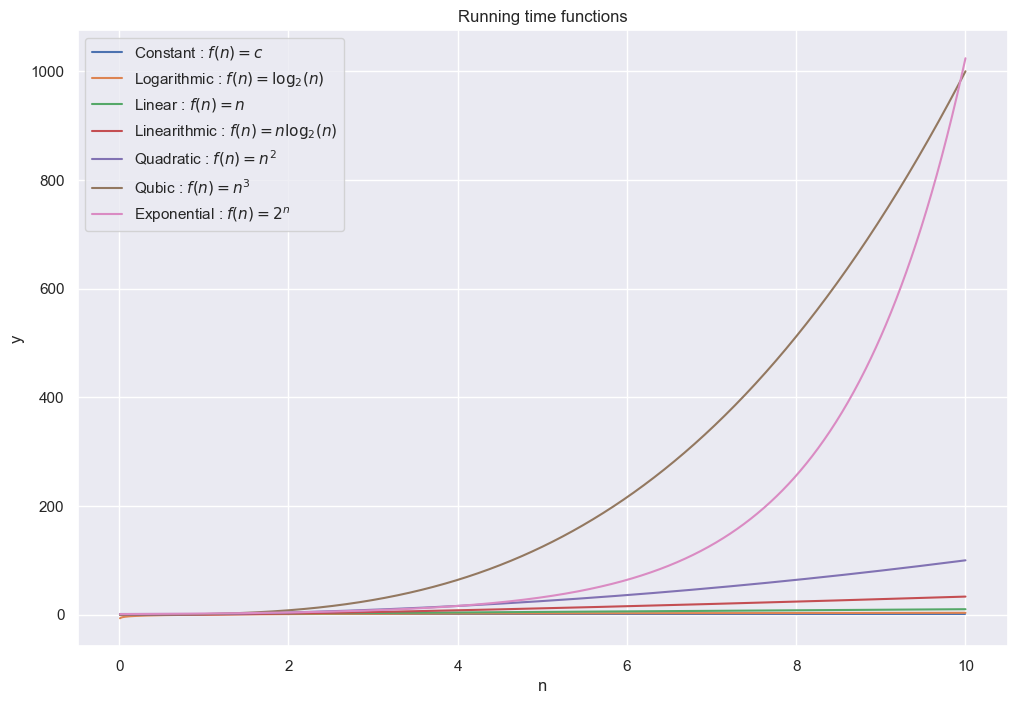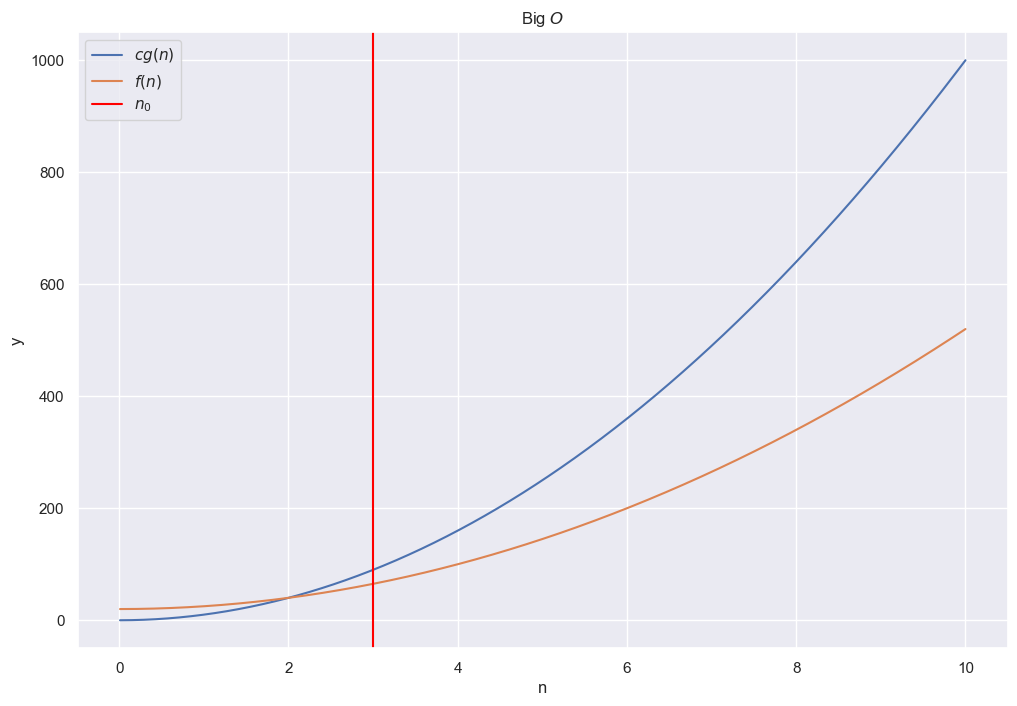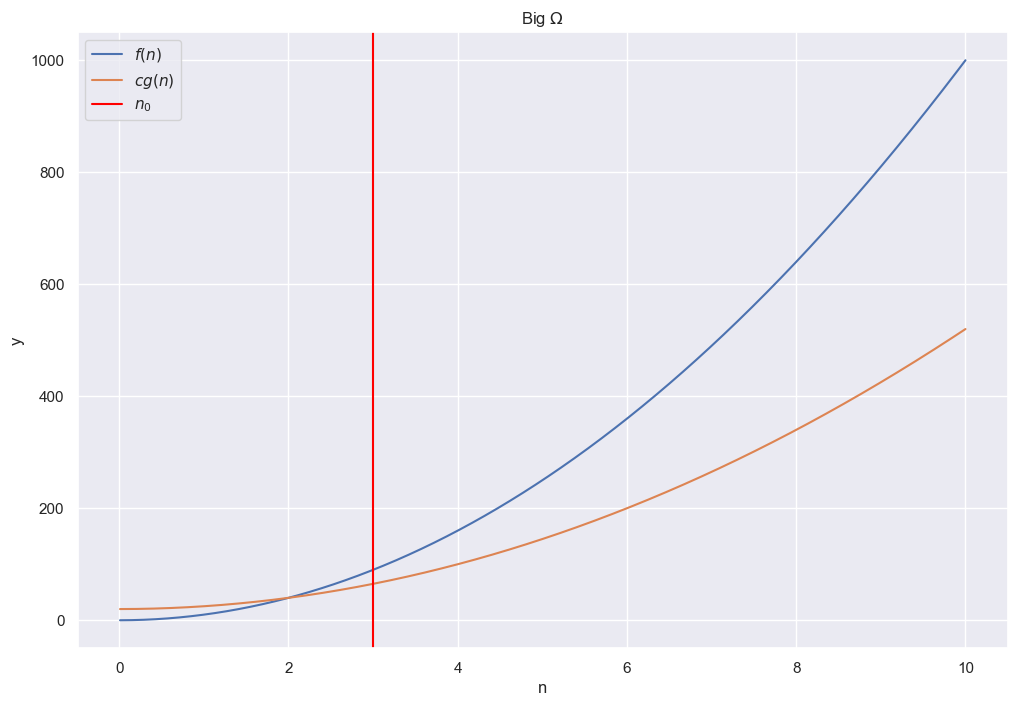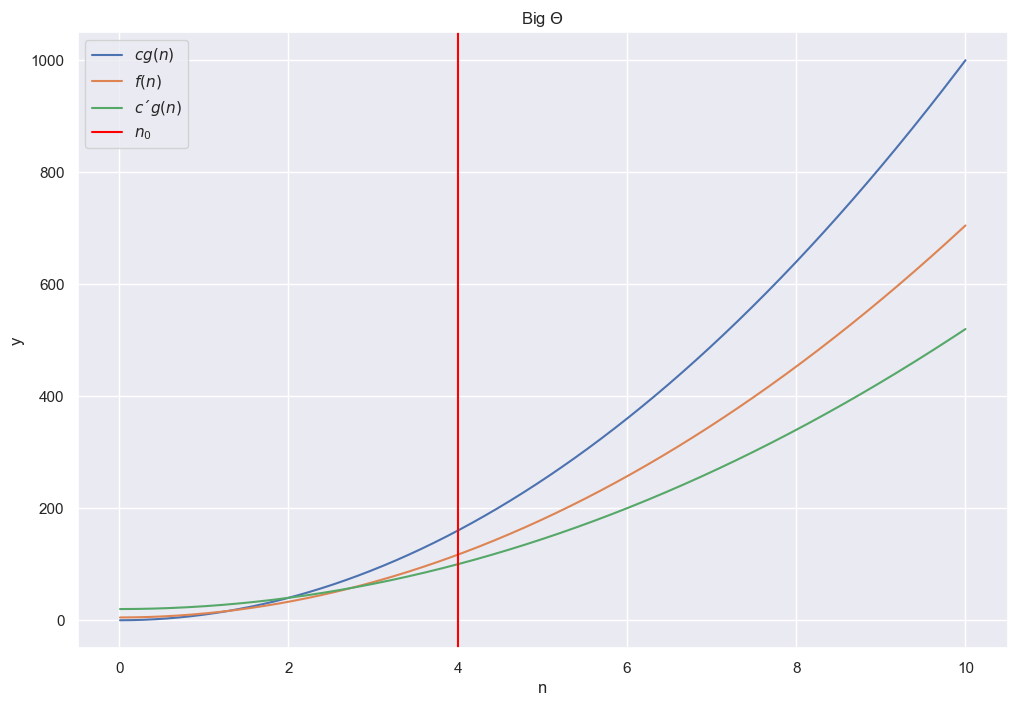Sorting
import numpy as np
import matplotlib.pyplot as plt
import seaborn as sns
import numpy as np
sns.set_theme()
In running time analysis we analyse the number of operations an algorithms needs. Often we look at upper or lower bounds of the amount of operations.
running_times = {'Constant': lambda n : n**0,
'Logarithmic': lambda n : np.log2(n),
'Linear': lambda n : n,
'Linearithmic': lambda n : n * np.log2(n),
'Quadratic': lambda n : n ** 2,
'Qubic': lambda n : n ** 3,
'Exponential': lambda n : 2**n}
functions = [r'$f(n) = c$', r'$f(n) = \log_2(n)$', r'$f(n) = n$', r'$f(n) = n \log_2(n)$', r'$f(n) = n^2$', r'$f(n) = n^3$', r'$f(n) = 2^n$']
n = np.linspace(0.01, 10, 1000)
plt.figure(figsize=(12, 8))
plt.title('Running time functions')
for fl, fs in zip(running_times.keys(), functions):
plt.plot(n, running_times[fl](n), label=f'{fl} : {fs}')
plt.xlabel('n')
plt.ylabel('y')
plt.legend()
plt.show();

f1 = lambda n : 10 * n**2
f2 = lambda n : 5 * n**2 + 20
plt.figure(figsize=(12, 8))
plt.title(r'Big $O$')
plt.plot(n, f1(n), label=r'$cg(n)$')
plt.plot(n, f2(n), label=r'$f(n)$')
plt.axvline(x=3, label=r'$n_0$', color='red')
plt.legend()
plt.xlabel('n')
plt.ylabel('y')
plt.show();

plt.figure(figsize=(12, 8))
plt.title(r'Big $\Omega$')
plt.plot(n, f1(n), label=r'$f(n)$')
plt.plot(n, f2(n), label=r'$cg(n)$')
plt.axvline(x=3, label=r'$n_0$', color='red')
plt.legend()
plt.xlabel('n')
plt.ylabel('y')
plt.show();

f3 = lambda n : 7 * n**2 + 5
plt.figure(figsize=(12, 8))
plt.title(r'Big $\Theta$')
plt.plot(n, f1(n), label=r'$cg(n)$')
plt.plot(n, f3(n), label=r'$f(n)$')
plt.plot(n, f2(n), label=r'$c´g(n)$')
plt.axvline(x=4, label=r'$n_0$', color='red')
plt.legend()
plt.xlabel('n')
plt.ylabel('y')
plt.show();

For the substitution method we guess the form of our solution and show the correctness through the use of induction.
Consider the following recursion $T(m) = 2 T(m/2) + \Theta(m)$ with $m = 2^k$, $k \in \mathbb{N}_{> 0}$. Then by using substitution we get
\[\begin{align*} T(m) &= 2 T(m/2) + c'm$ \\ &= 2 (2 T(m/4) + c'(m/2)) + \Theta(m)$ \\ &= 4 T(m/4) + 2c'm \\ &= 4 (2 T(m/8) + c'(m/4)) + 2c'm \\ &= 8 T(m/8) + 3 c'm \\ &= ... \\ &= k c'm + 2^k c_0 \\ &= c' m \log m + m c_0 \\ &\leq (c_0 + c')m \log_2 m \end{align*}\]Thus we guess that our running time is upper bounded by $O(m \log_2 m)$. Our hypothesis then becomes that our function is upper bounded $T(m) \leq c m \log_2 m$ for all $m\geq m_0$ for some $c, m_0 > 0$. We do the inductive step $m - 1 \rightarrow m$, where $m \geq 2 m_0$
\[\begin{align*} T(m) &= 2 T(m/2) + c'm \\ &\leq 2 c(m/2) \log_2 (m/2) + c'm \\ &= cm\log_2 m - cm \log_2 2 + c'm \\ &= cm \log_2 m - cm + c'm \\ & \leq cm \log_2 m \quad \text{for} \ c > c' \end{align*}\]Inductive steps works if we constrain c to be sufficiently large such that $cm \geq c′m$ for all $m \geq 2m_0$.
Now we need to show that $T(m) \leq cm\log_2 m$ for all $m$ with $m_0 \leq m \leq 2m_0$. Consider for this $m_0 = 2$.
Let $d = \max {T(2), T(3)}$. Then $T(2) \leq d \leq d 2 \log_2 2$ and $T(3) \leq d \leq d 3 \log_2 3$. With $c = \max{c’, d}$ it holds that for all $m \geq 2$ that
\[T(m) \leq cm\log_2 m\]In the recursion tree method, each node represents the cost of a single subproblem in the recursive invocation. Analyzing the cost on each level of the tree and the depth of the tree gives an idea of the overall running time.
The master theorem is often used for recurrent algorithms and is given by $T(n) = A T(n / B) + f(n)$. This is called the master recurrence, and the function $f(n)$ is called the driving function. The master theorem compares the asymptotic growth of the driving function to the one of the watershed function $n^{\log_B A}$.
Let $A \geq 1, B > 1$ be constant and $f(n)$ be a driving function that is defined and nonnegative on all sufficiently large reals. Let $T$ satisfy the master recurrence $T(n) = A T(n/B) + f(n)$. Then
\[\begin{align*} & f(n) = O(n^{\log_B A - \epsilon}), $\epsilon > 0 \\ \Rightarrow & T(n) = \Theta(n^{\log_B A}) \\ & f(n) = \Theta(n^{\log_B A} \log_2^k n), k \geq 0 \\ \Rightarrow & T(n) = \Theta(n^{\log_B A} \log_2^{k+1} n) \\ & f(n) = \Omega(n^{\log_B A + \epsilon}), \epsilon > 0 \ \text{and} \ A f(n/B) \leq cf(n), c < 1 \ \text{and sufficiently large n} \\ \Rightarrow & T(n) = \Theta(f(n)) \end{align*}\]Ignoring floors and ceilings does not generally affect the order of growth of the solution of a divide-and-conquer recurrence.
import numpy as np
```python import matplotlib.pyplot as plt import seaborn as sns import numpy as np
```python from future import annotations
A graph is a pair $(V, E)$ comprising of $V$, being a finite set of vertices and $E$ being a finite set of edges. Every edge connects two vertices $u$ and $...